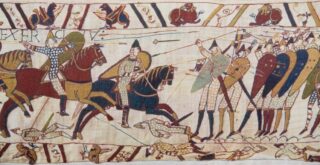Mortimers in the 15th century
Surviving records of Mortimers in the 1400s are hard to come by and possibly still hidden in the local and national archives. However, a peek into the court records of the time gives us an extraordinary window into the lives of some of the people at the time, particularly the ruling classes.
One particularly strange case that stands out from this era is that of the enigmatic Sir John Mortimer, knight, who became an unfortunate political victim of the Henry VI, a king so inadequate his reign eventually deteriorated into the Wars of the Roses.
Caught in the dynastic cross fire between England and France, John Mortimer served as a man at arms in the retinue of ——. Aggressively ambitious and combative, he was quickly knighted and appointed an important command of a naval force in 1417. While fighting in the Hundred Years War, he was captured by the French and imprisoned in ——. The English establishment under King Henry refused to pay his ransom, resulting in Mortimer being held prisoner for two years.
Even one year was a considerable length of time in the life of a medieval soldier, so to be held prisoner for this length of time in squalid conditions is unimaginable. Unsurprisingly, this once loyal servant of the Lancastrians, embittered with his mistreatment, became resentful towards the English regime. What use was loyalty to the King when it was repaid with only disrespect and injustice?
Mortimer was released in 1419 but then soon after arrested, apparently for inciting disloyalty with treasonous comments against the King and his bastard brother, the Duke of Gloucester.
While imprisoned in the tower, John Mortimer attempted to escape on several occasions. Conspirators supportive of him attempted to escape by boat down the Thames. Meeting with his kinsman the Earl of March, Mortimer would start a rebellion and make short work of the establishment.
The verdict was never in any doubt and the sentence for high treason was applied with immediate effect. Mortimer was executed immediately, with the full public display of hanging drawing and quartering.
This hasty change to the law in order to dispose of a troublesome political opponent was unprecedented and certainly underhanded. The unjust behaviour of the ruling elite was a direct factor that lead to 15th century unrest and the Yorkist challenge to the throne.
The House of York derived their claim to the throne through descent from Philippa Countess of Ulster and the Mortimer family.








Recent Comments